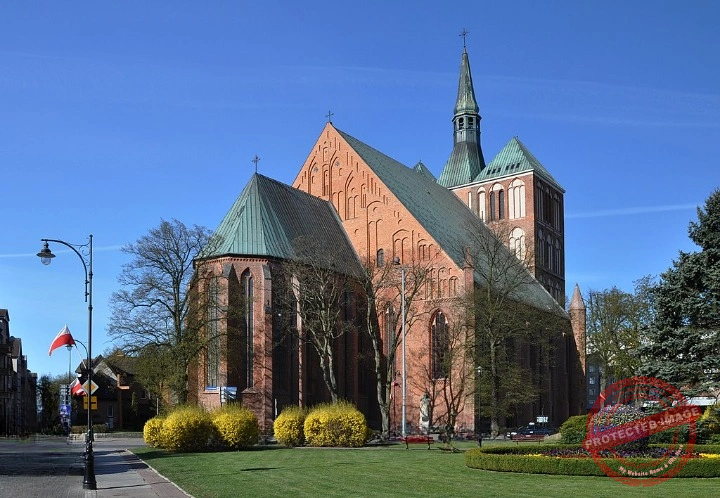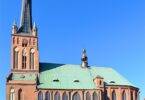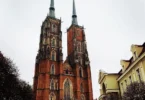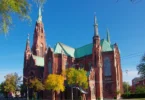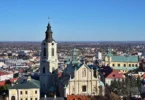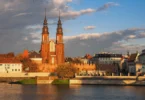Introduction
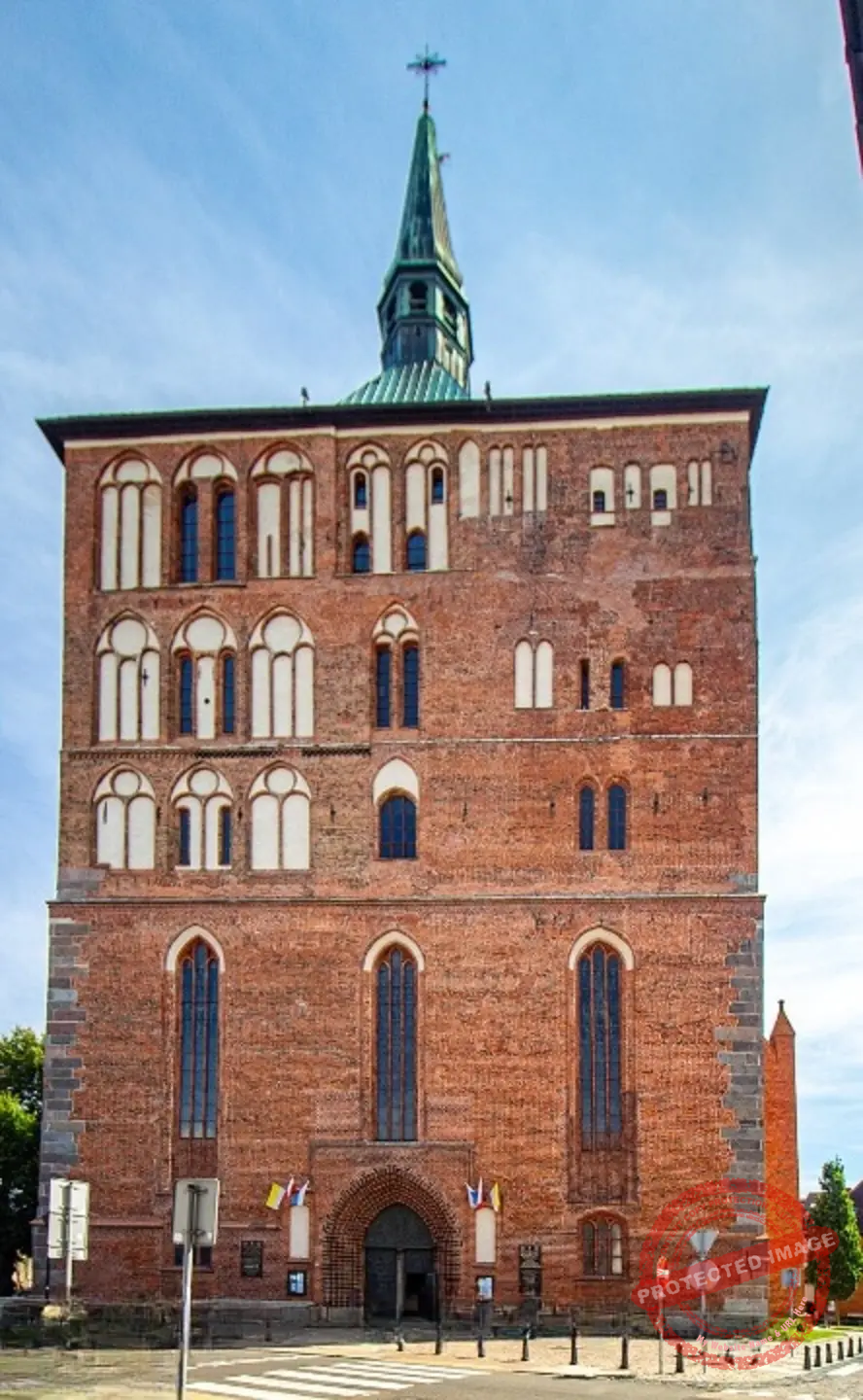
The Co-Cathedral Basilica of the Assumption of the Blessed Virgin Mary, often simply called the Kołobrzeg Cathedral, is one of the most important landmarks in the city of Kołobrzeg, Poland. This impressive Gothic church was built back in the 14th century and stands out for its unique structure it has five naves, which is quite rare. It serves not only as a parish church but also holds the title of a minor basilica. Since 1972, it’s also been the co-cathedral of the Diocese of Koszalin-Kołobrzeg. No one knows the exact year construction started, but most historians agree that it was likely in the early 1300s. It was built on the site of an even older church that had been dedicated to St. Nicholas. The first recorded mass in the new church took place in 1321. For a long time from the 1500s it was actually a Protestant church. Then, during World War II, in 1945, it became a key point in the defense of Kołobrzeg during the fierce battle for the city. Sadly, the building was heavily damaged by Soviet artillery during the fighting. In 1957, the ruins were handed back to the Catholic Church, and reconstruction began not long after. Today, the cathedral stands restored, not just as a place of worship but also as a symbol of the city’s long and often difficult history.
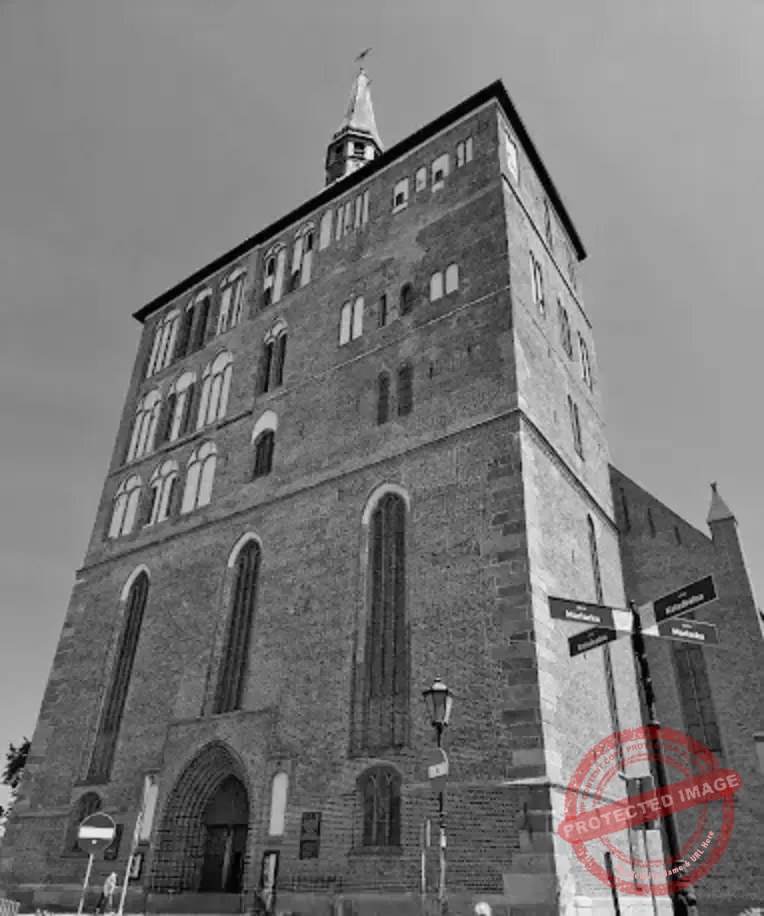
Catholic period
The exact date of commencement of construction of the parish church of the Blessed Virgin Mary in Kołobrzeg is not known. It is believed that the main city church was built in the early 14th century on the site of the former Church of St. Nicholas. The first mass at the construction site was celebrated in 1321. Over the next two centuries, the church was expanded and embellished. Due to subsidence, it was rebuilt several times. At the end of the 15th century, the north and south towers were combined into one massive tower block by bricking up the gap between them. A central dome was added, giving the church its final, monumental appearance, which has survived to this day. From the 14th century, St. Mary’s Church in Kołobrzeg served as a collegiate church.
The Evangelical period
From the 16th century it was a Lutheran church. Initially, it belonged to the Pomeranian Evangelical Church , and from 1817 to the Prussian Union Church. From the 17th to the 20th centuries, the church was repeatedly destroyed by warfare. In 1945, during the battle for the Kołobrzeg Fortress, it served as a key defensive point for the city. It was destroyed by Soviet artillery fire.
The Catholic period after World War II
After World War II, the church ruins were initially intended to be demolished. However, in 1957, it was transferred to the Catholic Church, and reconstruction began. In 1958, the collegiate church’s chancel was consecrated, and the first Mass was celebrated there. In the 1960s, by decision of the communist authorities, the Polish Arms Museum was established in the unreconstructed part of the church, and the main nave was used to exhibit heavy military equipment from the war. In 1974, the entire church was dedicated as a place of worship. In 1972, St. Mary’s Church in Kołobrzeg was established as a co-cathedral of the Koszalin-Kołobrzeg Diocese. In 1979, the church’s function as a collegiate church was restored. In 1980, a parish was established at the cathedral. On June 10, 1986, Pope John Paul II raised the parish church in Kołobrzeg to the dignity of a minor basilica. On October 23, 2007, the first ordinary of the Koszalin-Kołobrzeg diocese, Cardinal Ignacy Jeż , was buried in the crypt under the church.
Architecture of Co-Cathedral Basilica of the Assumption of the Blessed Virgin Mary, Kołobrzegu, Poland
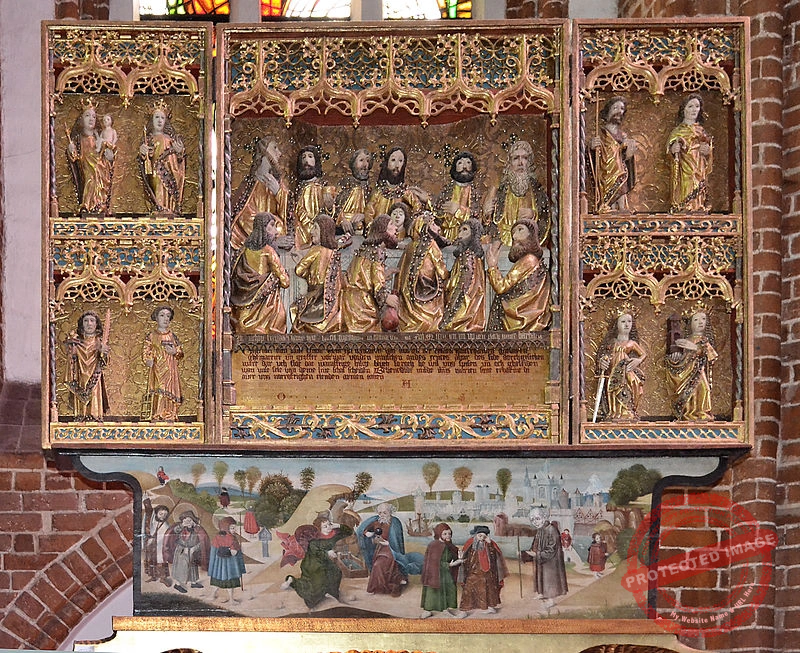
Architectural style: Brick Gothic architecture.
Equipment and monuments
The church’s repeated war damage over the centuries has meant that not many historical decorative elements or monuments of sacred art have been preserved inside. The temple contains the most valuable historical items, including.
Three wooden altars from the turn of the 15th/16th century
Of at least 22 Gothic altars in the Kołobrzeg cathedral, only 4 have survived: three of them are still in the cathedral, one is an exhibit at the National Museum in Szczecin. They were all made around the year 1500 and have the shape of a triptych. They were probably made by local artists and craftspeople. An altar referred to as “The Last Supper” can be found in the chancel. It was most likely written by Andrzej Wentzel, who also designed the main altar in the Koszalin cathedral. A painting titled “Annunciation of the Virgin Mary” appears on the reverse of the triptych’s wings, most likely by Jakub Vidrach. Scenes from St. Paul’s life are depicted on the predella, which is from another altar. James.To the left of the main altar is the “Adoration of the Magi” altarpiece. In addition to the title scene, it also contains figures of eight saints. On the reverse side, a scene of the Annunciation is painted. To the right of the main altar was the third altar. Figures of Saints can be found in the central cabinet. St. Anne and St. Nicholas. The same saints are depicted on the reverse of the triptych’s wings. Katarzyna Baden, the daughter of Koobrzeg’s mayor, set up the altar. The altar was constructed in the Master of the Chociwel Passion’s workshop.
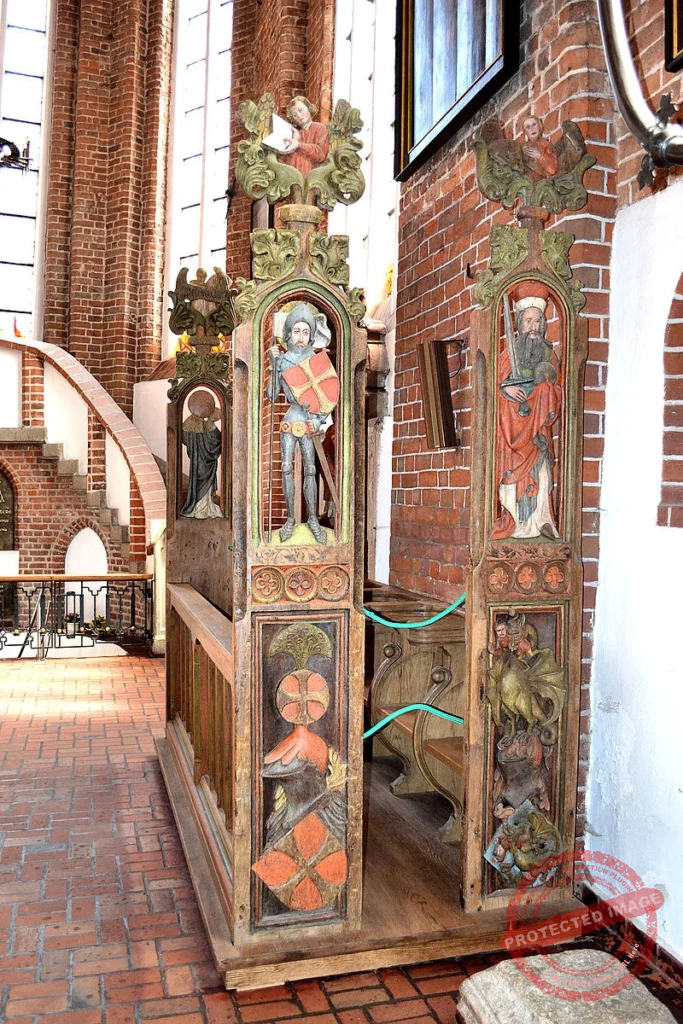
The stalls of the chapter and city councillors
The city council members’ modest but lavishly decorated stalls are located in the southern nave. The Koobrzeg patricians of the time were extremely wealthy, as evidenced by the splendor of their decorations. The stalls were probably built in a Cistercian workshop in the first quarter of the 15th century. Scenes of the Tyburt Sibyl and Emperor Augustus, Mary and the Child, a sinner who is devoured by a dragon-devil, a bishop, and a knight are all depicted on the sides of the stalls Helmets, shields, and other panoplies worn by knights are also visible. The oak stalls of the Koobrzeg church chapter have been preserved in the cathedral’s chancel. Bas-reliefs of dragons and manticores with human, canine, and dragon heads and long, branching tails are used to decorate them. The stalls were made in Herman Walther’s Koobrzeg woodcarving workshop around 1340. They are Poland’s oldest examples of this kind of thing.
Baptismal font from 1355
The baptismal font was cast in bronze by local craftsman Jan Alart. The baptismal bowl is supported by figures of four lions. On the side of the bowl are 26 bas-relief scenes from the life of Christ, arranged in two horizontal rows. A Latin inscription encircles the font: (translated:) “In the year of our Lord 1355, made by Jan Alart”. It is the oldest metal baptismal font in Western Pomerania.
The Last Supper bas-relief
The relief was part of a no longer existing altar from the end of the 17th century. The altar was funded by Gabriel Maurersberg and was located in the chancel. In 1807, during the siege of Kołobrzeg by Napoleon’s troops, one of the projectiles fired by General Loison’s troops fell on the chancel, destroying its furnishings, including the altar in question, of which only the predella with a depiction of the Last Supper remains. Among the apostles depicted in the relief, one can easily recognize Judas, who holds a purse full of silver pieces in his hand, and at his feet sits a dragon, the personification of the devil.
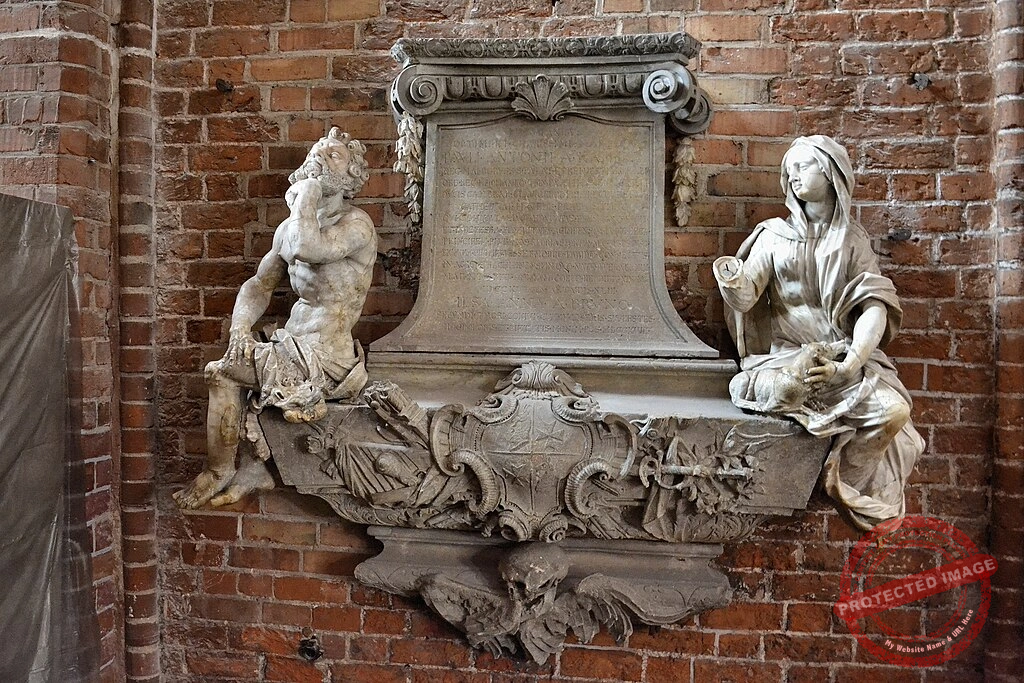
Tombstones and epitaphs
In the past, prominent citizens’ ashes were frequently interred in larger churches. Similar things occurred in Koobrzeg Cathedral. Originally, tombstones were set into the church floor, gradually filling it almost entirely. The slabs were removed from the floor during renovations from 1870 to 1990. The most valuable of them (22 in number) were placed vertically against the cathedral walls. Some of them have survived to this day. A Gothic tombstone depicting a young man named Benedict, which is currently situated next to a candlestick with seven branches, is thought to be the most valuable. In the part under the cathedral’s tower, two well-preserved tombstones and the Kameke family epitaph can be seen. After the Second World War, these works were transferred to the cathedral from the Strachomin church. The Baroque epitaph was carved from sandstone in 1718. Two alabaster figures, Diana holding a hart and Hercules holding a club, decorate it. The family crest, a panoply, and a relief of a winged skull are on the base of the epitaph. A bas-relief of Paulus Damitz and his wife is the most impressive of the artistic elements on the adjacent tombstones.
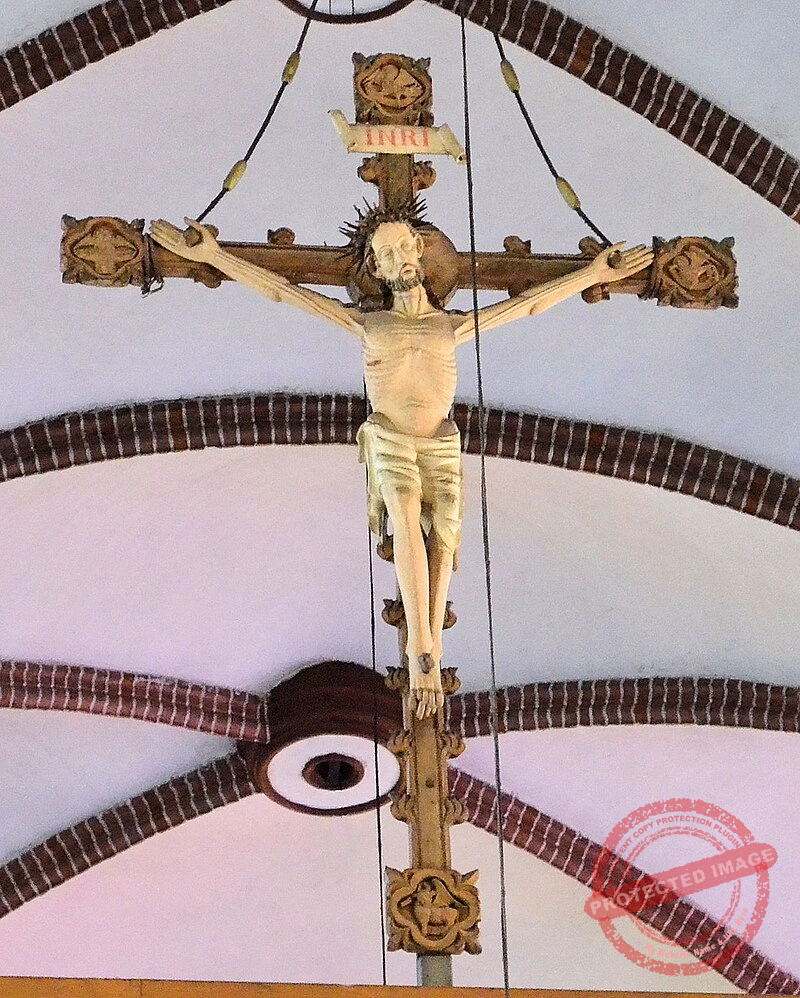
Crucifixes
Koobrzeg Cathedral has two Gothic crucifixes. Between the nave and the chancel, the larger of the two is mounted on the chancel beam. It is 2.2 meters wide and 3.5 meters tall. The crucifix was transferred to the cathedral in 1976 from the church in Ryma. It was made in the 14th century in the form of a “tree of life,” with offshoots and buds symbolizing the rebirth and flourishing of Christianity. The symbols of the Evangelists are located at the ends of the cross’s arms, and above Christ’s head is the inscription “INRI.” The sacristy of Koobrzeg Cathedral houses the second crucifix. It is significantly smaller than the one that was previously discussed. It is made of oak wood and is shaped like a “tree of life.” It was built in 1330.
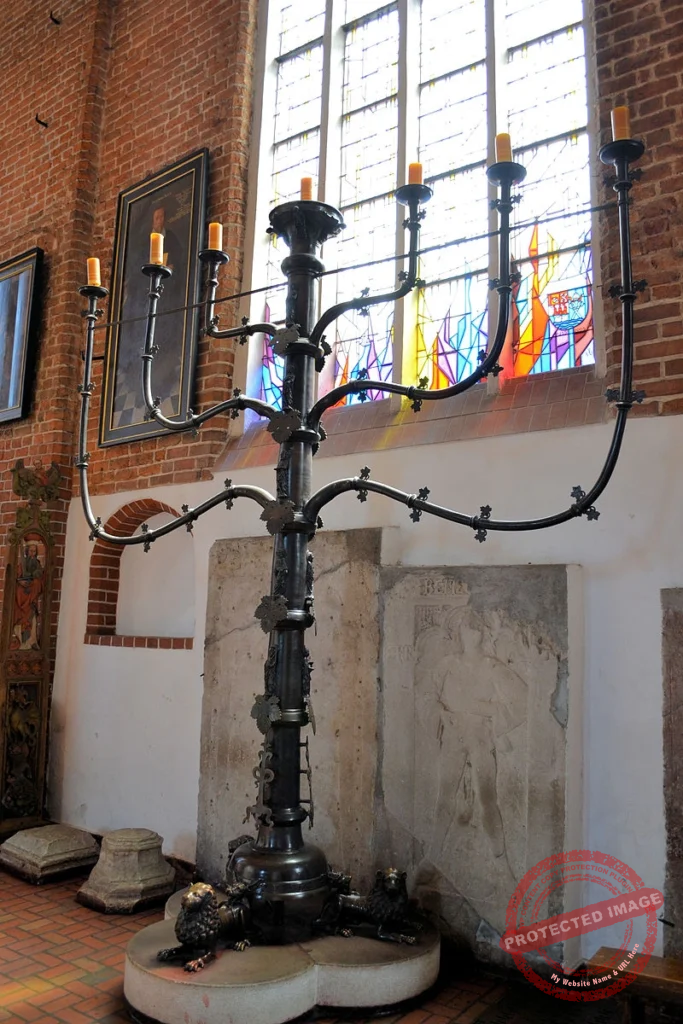
Candlesticks
Gothic seven-branched candlestick from 1327
It is the only Gothic candelabra that exists in Poland and one of only five that has been preserved worldwide. It measures 4 meters tall, has an arm span of 380 centimeters, and weighs over 900 kilograms. Gotfryd de Wida, the dean of the Koobrzeg chapter, left a testament that provided the money for it. Jan Apengeter used the lost-wax method to cast it in bronze in 1327. During the Seven Years’ War (1756-1763) and the Napoleonic Campaign (1807), the candelabra sustained minor damage. The candelabra was taken apart and stored in one of the church’s utility rooms during World War II. Polish workers accidentally discovered it there in the 1950s and sold it for scrap, unaware of its value. The candelabra was saved by Jan Frankowski, who purchased it from a scrap yard almost at the last minute. The candlestick was conserved in Warsaw, displayed at the Museum of Central Pomerania in Supsk, and returned to the Koobrzeg cathedral in 1981. The candlestick’s base is supported by three dragon heads, each resting on the back of a lion. This base, which is shaped like an upside-down bowl, is surrounded by two inscriptions: the lower one refers to the candlestick’s founder, and the upper one to its maker. Lilies, vine leaves, and images of the twelve apostles and four winged angels are arranged in the column of the candlestick. The Koobrzeg candlestick looks like a Jewish menorah because of its shape. It differs from it in the material from which it is made (bronze instead of gold) and in the fact that it consists of several parts (a menorah should be forged from a single piece of metal). The candlestick has a significant ideological and symbolic significance. The seven gifts of the Holy Spirit are symbolized by the candlestick’s seven burning candles. Christ’s words, “I am the vine, and you are the branches,” are referred to by the vine that encircles the candlestick’s column and arms. The candlestick’s base is covered in lilies, which are a representation of eternal life. It is challenging to make sense of the images on the candlestick’s base, which depict dragons and lions. These images have not yet been explained in detail.
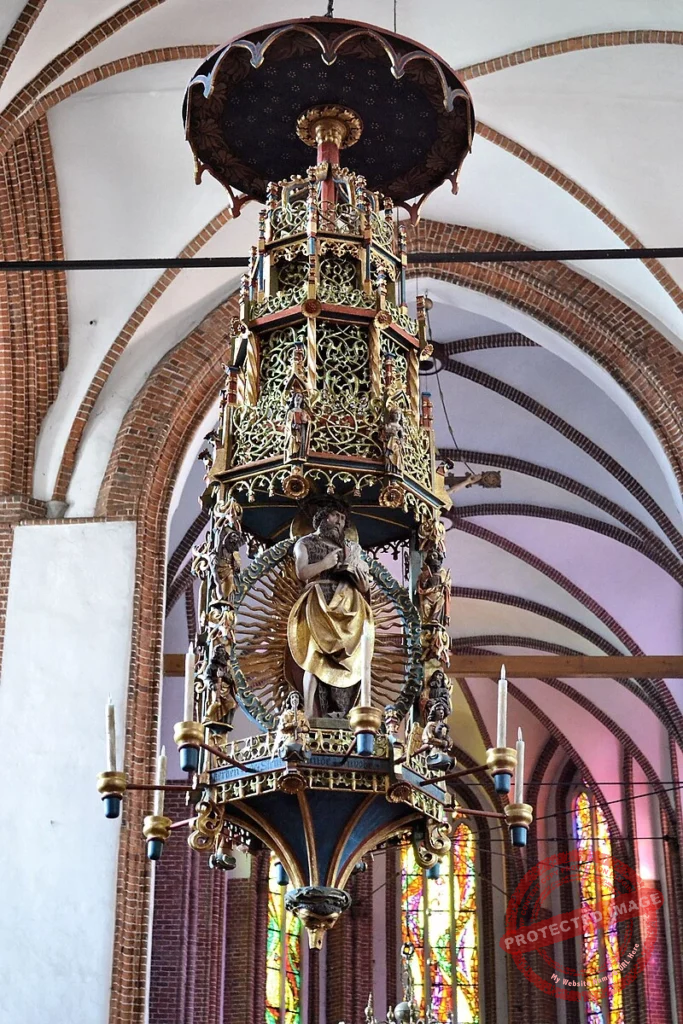
The Schlieffen Crown
A wooden hanging candlestick (chandelier) from 1523. The candlestick was funded by the old Schlieffen (Śliwin) family from Kołobrzeg, of Slavic origin. The candlestick was created in the workshop of Master Michael of Augsburg, the creator of the main altar in St. Mary’s Church in Gdańsk. The chandelier is considered a Gothic art style, but some of its elements already bear features of a new era the Renaissance (e.g., the facial features of the sculptures, the intricate carving of the upper part of the chandelier). The candlestick is decorated with two large, full-bodied sculptures of the Virgin Mary and Child and St. John the Baptist, as well as a dozen or so much smaller figures depicting the Twelve Apostles and musical angels. The chandelier is topped with a large canopy with a painted celestial vault. The entire piece is richly polychromed and gilded. According to the legend, the Schlieffens funded the candlestick to atone for their sins for the death of Jacob Adebar (he was sentenced to death in a trial in which the Schlieffen family was one of the main initiators).
Holken Crown
A brass hanging candlestick (chandelier) from 1420. The candlestick was donated by the Holken (Holk) family. The artist is unknown. In the center of the chandelier is a figure of the Virgin Mary and Child. The figure of Mary is surrounded by nine arched rods imitating the leafy shoots of a vine. The candlesticks are made in the shape of inverted crowns. It is the only surviving Gothic metal candlestick in Pomerania.
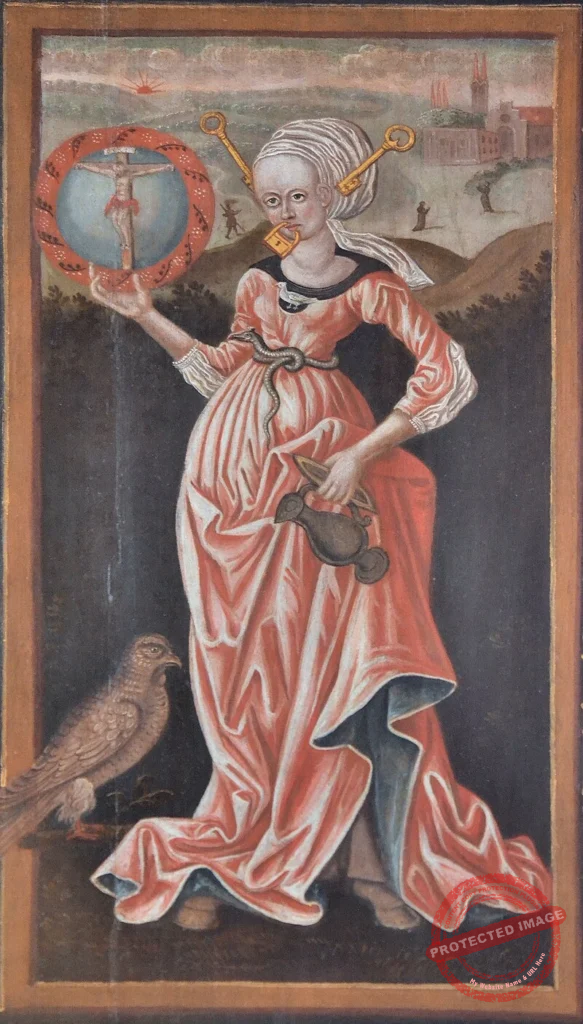
Pictures
A virtuous woman
A painting from 1494, executed using tempera. The name of Ivan von Coztenbach appears on the painting. It is unknown whether this person was the artist or the founder of the work. The center of the painting is occupied by the figure of a woman equipped with numerous attributes. Around it is a lengthy text in German explaining their meaning. The painting was created at the intersection of two eras: the Gothic and the Renaissance. The representation of the figures is still typical of the Middle Ages, but the painting contains novelties heralding the arrival of a new era: the emphasis on female beauty, the fact that the woman is a laywoman, not a clergyman, and the text in German, not Latin. The attributes visible in the painting can be interpreted as follows: a padlock and keys at the mouth and ears a warning against talkativeness and gossip; a crucifix in the hand symbolizes faith, and the wreath surrounding it is a symbol of purity and innocence. The snake encircling the woman’s waist is an attribute of prudence. The dove is associated with fidelity and gentleness. The falcon is a symbol of acumen and foresight. The horse’s hooves are an encouragement to trample on sin and evil.
Christ before Pilate
An oil painting on panel by Joachim Knochenhauer, created in 1640. The figures depicted in the painting wear costumes contemporary to the author (i.e., seventeenth-century).
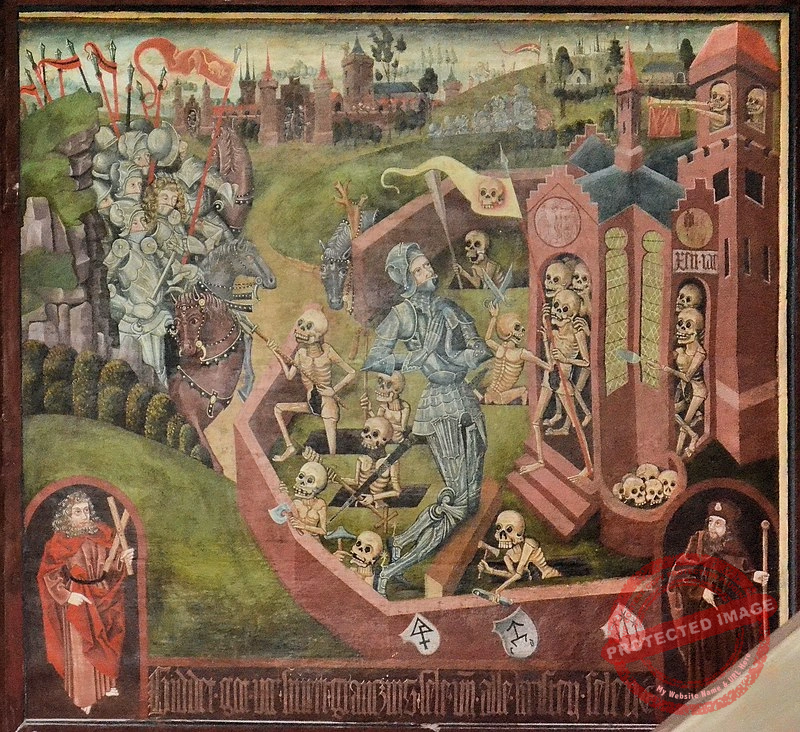
Knight in the Cemetery
Another name: Dance of Death a painting from 1492, executed in tempera on panel. It depicts a knight dressed in armor surrounded by skeletons of the dead rising from their graves. They hold the tools they used in life (e.g., a tailor’s skeleton holds scissors). These skeletons do not threaten the knight; on the contrary, they defend him from a group of mounted knights standing at the cemetery gates, above whom a red banner with the image of a dragon – a symbol of evil – flutters. This scene alludes to the belief that the dead provide support to the living if asked for in prayer (which is why the knight depicted in the foreground is praying). At the bottom of the painting are images of St. Andrew and St. James the Elder, and the inscription (translated): “Pray to God for the soul of Severt Grantzin” the painting is his epitaph.
Crucifixion
The painting dates from the first half of the 16th century and was executed in tempera on panel. It was most likely created by the Flemish painter Schmidt from Antwerp. The painting was stolen in 1990, but was soon recovered. The painting depicts Christ crucified with two thieves. A small silhouette of the founder is also visible, as well as the Virgin Mary and St. John the Evangelist standing beneath the cross. The latter two figures lack halos, indicating that the artist was already influenced by Protestant theology, which did not recognize the cult of saints or Mary.
Feast Day
Feast Day : 15 August
The feast day of the Co-Cathedral Basilica of the Assumption of the Blessed Virgin Mary in Kołobrzeg, Poland, is celebrated on August 15th. It marks the Solemnity of the Assumption of the Blessed Virgin Mary, the basilica’s patronal feast. This is one of the most important Marian celebrations in the Catholic Church.
Church Mass Timing
Monday to Saturday : 7:00 AM, 8:00 AM, 5:00 PM, 7:00 PM.
Sunday : 7:00 AM, 8:30 AM, 10:00 AM, 11:30 AM, 1:00 PM, 4:00 PM, 5:00 PM, 7:00 PM, 8:00 PM.
Church Opening Time:
Monday to Sunday : Open 24 hours
Contact Info
Address : Co-Cathedral and Basilica of the Assumption, Kołobrzegu, Poland
Mariacka 5, 78-100 Kołobrzeg, Poland.
Phone : +48 94 352 61 50
Accommodations
Connectivities
Airway
Co-Cathedral Basilica of the Assumption of the Blessed Virgin Mary, Kołobrzegu, Poland, to Szczecin-Goleniów Solidarity Airport (SZZ), distance between 57m (91.0 km) via S6.
Railway
Co-Cathedral Basilica of the Assumption of the Blessed Virgin Mary, Kołobrzegu, Poland, to Kołobrzeg, aleja Kolejowa Kołobrzeg train station distance between 9m (2.0 km) via Dworcowa.

